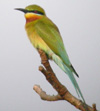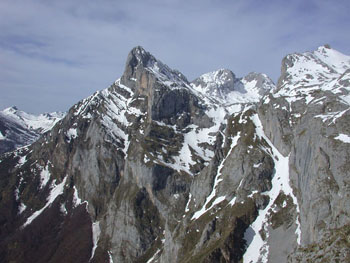
Real Birder
 |
Real Birder |
||||
| |
Spain - March 11th to 25th 2003 |
|
INTRODUCTION
The timing of the trip took into account the movements of high mountain species, which normally return to upper levels with the onset of warmer weather, making them far more difficult to see. It is worth noting, a trip at this time of the year will exclude many of the migrant passerines which pass through Spain during the second half of the month of April.
RESEARCH & LOGISTICS Birding sites visited were taken from Gostours
Guide: Finding Birds in Northern Spain and
John Muddeman’s A Birdwatching Guide to Extremadura. Other useful books were Where to Watch Birds in Northern and Eastern Spain
Car hire was from Hertz, booked through Holiday Autos. On arrival at Barrajas Airport we were upgraded to a larger more comfortable Ford Mondeo diesel, which served us well, especially in view of the distance travelled. Departure via the Hertz check in lot was equally painless, with the car just being parked and keys handed in - no other formalities. All hotels were selected and booked on
the internet, well in advance of our departure. Our first stop was in Zaragoza for 2 nights at Hotel Hesperia. Moving north we then headed for Huesca which was to be our base for the Pyrenees leg of our trip. DIARY
Wednesday 12th March (Day
2 Bird List) The few birds seen whilst travelling from Madrid to Zaragoza on the 11th
are included in today's list. Awaking refreshed after yesterday's long journey, we set out to visit Belchite,
Sastrago, Escatron, Laguna la Playa and Bujaralloz (Gostours
Pages 8/9). At the Lomazas Steppe Reserve Belchite we had excellent views of at least 3 singing Dupont's Lark, getting our trip off to an excellent start as we only arrived at the site around noon and the birds are said to be easier to see either early morning or late afternoon. Thursday 13th March (Day3 Bird List) Today we left Zaragoza for Huesca in the Spanish Pyrenees. Overnight at Hotel Pedro I de Aragon 13th, 14th & 15th. Having checked into our hotel we visited the Embalse de Vadiello via Loporozano in search of raptors and the elusive Wallcreeper. We had the first of relatively numerous Egyptian Vultures, along with many Griffon Vultures at the dam, where we also had a very brief fly-by of our only Lammergeier of the trip, but failed completely with the Wallcreeper. At Loporozano we had the first of only two Golden Eagles for the trip, an immature bird. 33 species for the day, taking our list total to 57, with yet another lifer.
Saturday 15th March (Day 5 Bird List) On our last day in the Pyrenees we went back to the Vadiello Dam and moved on to the Laguna de Sarinena before visiting Piraces on our way back to the hotel. 
Our early morning call at Vadiello was rewarded with a close up view of the much sought after Wallcreeper working a tunnel face near to the Dam and displaying his colours, before flying across to the opposite wall of the gorge to continue feeding. We also had our first Bonelli's Eagle here. At Sarinena Lagoon we had our only Garganey of the trip amongst a host of other ducks and walking around the lagoon to its southern outlet we saw our only trip record of Yellow Wagtail of the Iberiae race and a small colony of Tree Sparrow. The Reed Buntings here exhibited a kind of behaviour we have never seen elsewhere: I can only assume it was a form of display flight as numerous birds continually flew up from the reeds approx 1 metre, before dropping immediately down again. The upward flight looked as though powered by a springed jump! On our way back to the hotel we stopped at likely habitat near Piraces and had close up views of pairs of Black Wheatear and Rock Sparrow. 62 birds for the day, swelling the trip list to 93 species. The Wallcreeper provided another lifer and one of the trip highlights for me. Sunday 16th March (Day 6 Bird List) Today we left the Spanish Pyrenees and travelled from Huesca to Potes in the Picos de Europa. To break up the long journey en route we visited the estuary of San Vicente. (Gostours Pages 32/33). Overnight Parador de Fuente De 16th, 17th & 18th. Although we only saw 36 species today, trip list numbers moved on to 101 with Kentish Plover and several other waders, gulls and a Sandwich Tern from the road bridge at San Vicente.
Tuesday 18th March (Day 8 Bird List) Sites visited today included Panes, San Glorio Pass and Riano Reservoir (Gostours Pages 34/35). We originally intended to visit the Cares Gorge but the main road was closed for roadworks east of Panes and we had to do a swift about turn and adopt Plan B. Not really ideal as we were travelling the same route the next day on our way south. However it did give us more time to explore the area and enjoy the magnificent scenery. We had our only Bullfinch sighting of the trip with a male and two females in roadside bushes as we ascended the San Glorio Pass. Wednesday 19th March (Day 9 Bird List) Leaving the Picos De Europa we travelled south via Potes to Benavente. Overnight Parador de Benavente for 1 night. Before checking in to the Parador we headed further south and visited the Lagunas de Villafafila including Salina Grande and surrounding plains. Before reaching Benevente we had our only other trip sighting of Spanish Imperial Eagle and the first of many Montagu's Harriers we were to see over the next few days. Both the daily list and overall trip numbers were enhanced by our only sightings of numerous ducks and waders, common in the UK, around the various lagoons at Villafaila. Amongst the more common species we had 3 White-fronted Goose, 2 Ruddy Shelduck and 3 Bar-headed Goose. Although one of the Bar-heads was a feral bird, we were assured by the Reserve wardens the other two were wild - another lifer. On the plains around Villafafila we had numerous flocks of Great Bustard, some in excess of 50 birds. Species total for the day was 65 and the trip list accelerated to 127.
Friday 21st March (Day 11 Bird List) Today we visited numerous tracks around Santa Marta de Magasca, La Encinilla and Monroy (Gostours Pages 26/27) as we travelled west from Trujillo and north of Caceres. Our first full day in Extremadura saw changing species from the regulars previously encountered. Before we left Trujillo we had our first Lesser Kestrel and Pallid Swift, both of which have flourishing breeding colonies in the town. The tracks around Santa Marta de Magasca were particularly productive, leading us to visit the area almost every day thereafter. Here we had c20 Little Bustard, c8 Great Bustard, Hoopoe, 3 Stone Curlew, c20 Pin-tailed Sandgrouse feeding in the fields, c30 Black-bellied Sandgrouse flying overhead giving their distinctive call, numerous Woodlark on passage, a single Cuckoo and the only Great Spotted Cuckoo of the trip, with a party of 3 birds. As was expected Montagu's Harrier were literally everywhere. Unfortunately we were too early for Roller but we did have excellent views of Honey Buzzard flying overhead plus a Golden Eagle near Monroy. The colony of Alpine Swift on the Rio Almonte was our only sighting of the trip and we finished the day with a healthy 63 species as our trip total was lifted to 144. We had an excellent lunch today in a small bar/cafe in the centre of Santa Marta de Magasca and the Sandgrouse provided two more lifers. Saturday 22nd March (Day 12 Bird List) Sites visited today were Zorita, Embalse de Sierra Brava and Madrigalejo (Muddeman Birdwatching Guide to Extremadura Page 78) as we travelled south-east from Trujillo and, on our return, Santa Marta De Magasca tracks, before we headed back to Monfrague and the Eagle Owl site near Embalse de Torrejon. Sunday 23rd March (Day13 Bird List) Once again we visited Santa Marta De Magasca to start the day & then various sites
south of Caceres (Gostours Pages 20/21) including Aliseda and Rivera de la Muela, south of La Rocha de la Sierra, as we attempted to catch up with Black-shouldered Kite. All the usual birds were seen at Santa Marta de Magasca including a large roost of Montagu's Harrier. The Lesser Kestrel colony in Trujillo had grown substantially since our arrival and birds now exceeded 50. Particularly noteworthy were 4 Black Vulture flying over us near Aliseda, where we also had Nuthatch and 2 Great Spotted Woodpecker in a peaceful olive grove. Monday 24th March (Day 14) Was taken up by travelling to Madrid, finding accommodation and enjoying some sightseeing around the city. We did manage to pick up 20 species for the day including the biggest flock of Cattle Egret we had seen with about 300 birds roosting in roadside trees. Tuesday 25th March (Day 15) After a morning of culture around some of Madrid's Art Galleries and Museums we, returned to Liverpool by Easyjet on a mid afternoon flight.
MEMORABLE MOMENTS
Our 4hr drive from Madrid to Zaragoza and then our 2hr drive around Zaragoza totally lost in the dark, jumping red lights going up one-way streets the wrong way, trying to understand instructions given in pidgin English and then finally abandoning the vehicles and finding the hotel on foot. 3 Dupont’s Larks display flying and singing at mid-day in bright sunlight, totally contrary to the popular myth that they only sing at first & last light (Belchite). A pair of Alpine Accentors, totally ignoring our presence for over an hour whilst they fed on microscopic food around our feet (Picos de Europa). Dozens upon dozens of Griffon Vultures, gliding less than 15 metres above our heads, whilst we picnicked at the mirador on the San Glorio Pass (Picos de Europa).
2 Greater Spotted Cuckoos, pair bond feeding on a fence, several feet from our vehicle, with a third close by (Extremadura). Super views of 3 Black-shouldered Kites sat in the top of a tree (Extremadura).
SUMMARY We enjoyed good weather and had an excellent time, seeing some super birds on the way, with a total of 153 species for the trip, 12 of which were lifers:-Alpine Accentor, Alpine Chough, Black Vulture, Black Wheatear, Bar-headed Goose, Black-bellied & Pin-tailed Sandgrouse, Dupont’s Lark, Eagle Owl, Lammergeier, Snow Finch and Wallcreeper. Although arduous at times, with a number of long drives, we would recommend this itinerary to anyone wishing to pick up a good number of the specialist species of the area.
David and Amanda Mason |
| ©2012 Real Birder | Home • Photos • Trip Reports• Links • Contact Us |